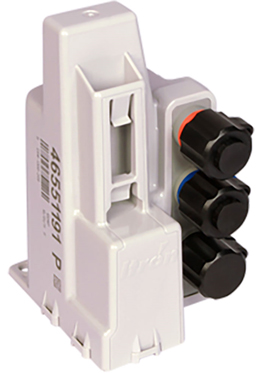Is Transitioning From AMR To AMI Worth The Effort?

For the water department at the City of Fairborn, Ohio, switching from manual meter reading to automated meter reading (AMR) and eventually to advanced metering infrastructure (AMI) has made a small operations staff more productive, provided more timely information for the city’s water treatment plant and distribution system, and tremendously improved customer service. Learn about the benefits captured and lessons learned along the way.
Moving from AMR to AMI technology can pay off in many ways, as the city has learned over the years. When the city installed its AMR system with Itron in 1999-2000, it simply kept the monthly meter reading and billing schedules for the three districts serving 13,500 accounts and 33,000 residents. But in 2017, as that turn-of-the-century AMR infrastructure started to exceed its projected lifespan and the service team was replacing up to a half-dozen customer location transmitters daily, the city began to evaluate the benefits of upgrading to AMI.
Saving Labor is Good; Being Timely is Even Better
Initially, the decision to upgrade from manual meter reading to AMR provided expected labor savings and digital accuracy that minimized data entry errors without requiring meter readers to physically roll a truck to visit every customer location each billing period. Even as those savings and conveniences of drive-by data capture accrued, since billing data collection still occurred only on a monthly basis, long gaps between readings masked a lot of problems. Moving to AMI took the automation concept one step further, enabling digital data readings on a daily, even hourly, basis and making it easier to spot sudden changes or evolving trends more quickly and easily. Best of all, the utility learned that benefits began to span all aspects of operational and stakeholder interests (Figure 1).

Photo courtesy of Itron
Figure 1. This free Value Calculator lets prospective AMI system users evaluate the potential reward of migrating to an AMI solution based on answering eight basic questions. Users can then tweak the calculator results according to unique operating parameters in their system.
- Operational Enhancements. AMI’s data collection and access capabilities give utilities more timely insight into performance by pinpointing changes almost immediately instead of having to wait one or more monthly billing cycles to identify equipment failure or abnormal usage.
- Customer-Centric Service. AMI offers benefits to more than just utility workers. It can also be used to engage customers with new access to data that keeps them more closely attuned to, and in control of, their water use. Making hourly data available through a web-accessible customer portal can raise awareness, minimize customer service calls, substantiate billing accuracy, and help consumers take control over their consumption habits to manage monthly bills.
- Greater Visibility to Network Status. Beyond billing, having more granular visibility into the water-distribution network makes it easier for utilities to monitor the impacts of aging infrastructure, identify and reduce non-revenue water and leaks, and streamline operational costs. Setting notification parameters for automatically collected data makes it easier to identify sudden or subtle changes that could indicate potential problems. For example, unusual meter reading patterns over time can flag slow leaks or burst leaks and even trigger automatic customer notifications, enabling the utility to take action right away, avoiding property damage and wasted water.
- Unanticipated Benefits. Further, AMI advantages have paid added dividends in the aftermath of the recent global coronavirus pandemic. Fully automated data collection limits field crew exposure. Online access to customer meter data enables utilities to enhance customer satisfaction while minimizing service representative contact. And with secure access, authorized employees can access applications and reporting remotely while working from home, helping to ensure service and support continuity.
Putting Theory Into Practice
Migrating from AMR to an AMI solution has enabled the City of Fairborn to collect and analyze water consumption data and integrate it into a central billing and analytics system on a daily basis, eliminating the need to rely on a once-a-month snapshot. When it was time to take the next step in automation, the city chose to deploy proven encoder receiver transmitter (ERT) technology from Itron that ‘plays nice’ with many types of meters, protecting flexibility for future meter replacement (Figure 2).

Photo courtesy of Itron
Figure 2. Versatile encoder receiver transmitters (ERTs) that can work across both AMR and AMI systems and with water meters from a wide variety of manufacturers can save on capital expense and make for a smooth transition. Data transmission options in AMR and AMI mode provide utilities with configuration choices to conserve battery life while meeting different application requirements.
Signals from the individual customer meters are transmitted back to the utility’s billing office through a fixed network of collectors and repeaters. Collecting multiple daily readings gives the city a more accurate and detailed view of water consumption and trends and helps to flag instances of potential non-revenue water such as activity on supposedly vacant properties or the loss of signals at active accounts. The city also uses leak data to provide adjustments on customers’ sewer bills for ‘undetectable leaks’ — where the water leaked into the ground instead of down the drain and into the sewer system. In the future, Fairborn is also looking to complement its quadrennial leak studies with periodic comparisons of daily treatment volumes vs. daily billing volumes, helping the city understand where the water is going and streamlining operations.
In addition to operational management uses, the city also uses the data to support its customer service department. It utilizes a user-friendly online customer portal, which the city promotes every opportunity it gets — through bills, texts, emails, and on its website. That makes user data accessible to individual customers to empower them with greater understanding and control over their own water usage. As part of that service, the city established default parameters for automated customer notifications involving continuous leaks (constant, low-level use for 72 hours straight) and burst leaks (elevated-volume use for 8 hours straight). Customers can also add their own parameters for additional notification requests.
The Proof Is in the Performance
The three biggest concerns going into the project — software integration, managing data storage, and customer reactions — turned out smoother than expected, thanks to the city spelling out its plans and expectations in detail and proactively addressing them with all supporting vendors, programmers, and product managers. With the city’s relatively small IT department, a managed service offering presented the best choice to save a lot of time, effort, and upfront capital expense, while making the transition go smoothly.
One early harbinger of success cited by Danielle Wolfe, the revenue manager for the City of Fairborn, came from a property manager of Wright State University student housing who used the customer portal to identify 29 leaking toilets and a slab leak within the first month. Because 70 percent of Fairborn’s population lives in rental properties — including multiunit buildings on a single meter — landlords especially appreciate the timely data available through the customer portal. Wolfe reports that individual customers also compliment the utility on a daily basis for the ability to spot unanticipated water consumption and proactively notify customers of potential issues.
One unique way Wolfe is leveraging the city’s upgraded AMI capabilities during the coronavirus pandemic is to use access to granular consumption data to help project revenue shortfalls based on comparisons of commercial hotel water usage for equal time periods before and after the local shelter-in-place order.
Once Wolfe has two complete years of AMI data, she anticipates being able to compare year-over-year statistics to pinpoint seasonal fluctuations and create more accurate future water usage and revenue forecasts. Identifying distribution system water loss is another anticipated area of interest and, of course, promoting even greater customer portal engagement will be a continuing part of the effort.
When asked for advice the utility would give to other utilities considering AMI, Wolfe responded that “It is worth it. Our staff has seen that. It’s a lot of data coming in; it’s a lot of verifying and making sure that everything is right. But it’s absolutely been worth it.”
Watch a video where Wolfe discusses the benefits of migrating from AMR to AMI for the City of Fairborn or learn more here.
